Whether you’re a Restaurant Manager, Event Planner or hospitality business owner, you probably know that a great Bartender can make a huge difference in the quality of the service your establishment or business provides.
That's why, in this article, we answer all of these questions you might have about hiring the right Bartender for your establishment. We’ll also guide you through the job hiring process to ensure you attract the most qualified applicants.
Why Hire a Bartender?
A professional Bartender can provide a lot of value to a hospitality business, regardless of whether it’s a nightclub, bar, restaurant or event planning company. Besides serving drinks, a good Bartender will provide exceptional customer service through interaction. This, in turn, can help bring in repeat customers, ultimately boosting revenue.
Hiring a passionate Bartender who considers their profession as an art form and always strives to perfect cocktail recipes, perform flair bartending and engage with customers can go a long way in improving your reputation.
How and Where To Find a Bartender
You can take a few different approaches to find a Bartender for your establishment:
1. Promote From Within the Company
If you already employ a Barback or Server who’s shown eagerness to move to a bartending role, you can consider promoting them. While they might need a short onboarding period to settle into the bartending role, they’re probably already familiar enough with your business operations to know the gist of things from the get-go.
But before you consider promoting a candidate, you should make sure they already possess the following skill set:
- Customer service expertise: They should already have strong communication skills and know how to handle customer interactions with ease and a smile. If they’re a natural at making people feel welcome, they’re off to a good start.
- Multitasking ability: Bartending isn’t just about pouring drinks — it’s about managing multiple orders, keeping track of payments and staying calm under pressure. If your internal candidate has shown they can juggle various tasks without missing a beat, that’s a big plus.
- Basic drink knowledge: They don’t need to know how to mix every cocktail right away, but having a good grasp of popular drinks and the basics is important. For instance, if they know the difference between a martini and a margarita, then they’re on the right track.
- Attention to detail: Whether it’s getting ingredient measurements right or keeping the bar area spotless, paying attention to the little things makes a big difference. If they’re already the kind of person who notices and fixes things before being asked, they’ve got the right mindset.
If you have an employee who possesses these skills, you may just find this hiring approach suitable. However, there are still pros and cons to consider before making the final decision:
To help them onboard, have one of your already-established Bartenders give them on-the-job training to help them learn the ins and outs of bartending.
You can also ask these employees to take a few online bartending courses or classes at a bartending school before you officially promote them. This will help negate some of the cons of promoting internally.
Hiring timeline for internal promotion: Internal promotions can typically be completed within one to three weeks. The specific timeline will depend on the candidate’s existing skill set and the amount of training required to get them fully up to speed.
2. Put Up Signs at Your Store and Around Nearby Areas
Putting up signs is a simple and budget-friendly way to spread the word that you’re hiring. Don’t just stick to the storefront window — think about using signs inside your establishment and in nearby high-traffic areas too.

Below are some tips for stand-out sign placement:
- Storefront window: Make sure your sign is at eye level so people walking by can’t miss it. Keep the text big, bold and easy to read — even from a distance.
- Inside the store: Position signs near the entrance or exit, where customers are more likely to see them. If you’ve got a bulletin board Got a bulletin board? That’s a great spot too!
- Outside the store: Check out community bulletin boards or partner with nearby businesses like coffee shops or bookstores. Local colleges with hospitality programs are also a good option. Just remember to ask for permission before putting up your sign.
Your signs should be straightforward and eye-catching. These should include the job title of the position you're hiring for and details on how to apply and where to get more information. Use phrases like “Now Hiring Bartenders!” or “Join Our Team as a Bartender!” to grab attention. Of course, make sure that the text is large enough and highly visible.
If you have the budget, hiring a graphic designer is always a good idea for a polished look. But if that’s not an option, you can still create professional-looking signs using free or affordable templates from sites like Canva or Vistaprint.
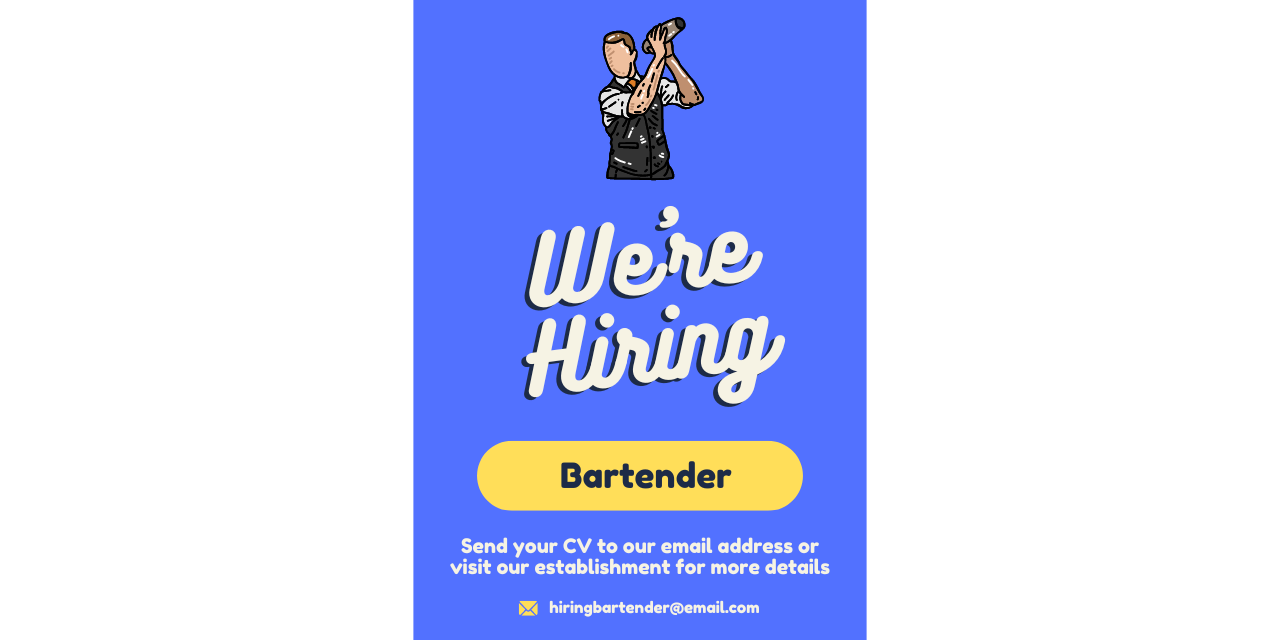
While posting job ads online is often the more popular method nowadays, physical ads help build a local presence that online ads can’t always match, making them a valuable tool for attracting talent. They can catch the eye of passersby and bring in walk-in applicants right away — especially if you’re in a busy area.
When to expect results from sign ads: You’ll usually see some interest within a week or two. The key is where you place them; the more visible and high-traffic the location, the faster you’ll get results.
3. Spread the Word Using Social Media
You can post on your social media platforms like Facebook and Instagram to let your followers know that you have an open job position. Your social media posts should contain an engaging image with a bit more information (like a short list of qualifications) that your followers would immediately see.
Also, it’s best to keep the dimensions of these images to 1080x1080 pixels (square), like the example below:
Alternatively, you can add more visuals to your image — such as a photo of your establishment — to make it stand out further. As for the caption, it should be concise with basic information such as the location (if you’re a multi-unit restaurant) and how to apply.
Here’s a sample caption:
“We’re looking for a Bartender to join our team at our location in [Area/Neighborhood]! 🍹 DM, email, or visit [link to your website] to apply! #BartenderJobs #NowHiring #JoinOurTeam”
Adding hashtags like #BartenderJobs, #NowHiring and #JoinOurTeam helps your post reach more people who might be searching for job opportunities. You can also include location-specific hashtags (like #NYCJobs or #WilliamsburgBartenderJobs) to target candidates in your area.
If you have a bit of budget to spare, consider boosting your post with Facebook or Instagram ads. Geotargeting allows you to show your job ad to people in specific locations — like within a certain radius of your bar or restaurant.
This can be super effective for reaching local talent who might not already be following your page. Just make sure to set a reasonable budget and time frame for your ads to get the best results.
When to expect results from social media posts: You’ll typically see interest within a few days, especially if you’re using hashtags and targeting the right audience. Expect most responses within two to three weeks, depending on engagement and whether you’re boosting posts.
4. Post on Job Boards
You can post your Bartender job ad on platforms that showcase hospitality jobs. You can check out this article for top recommendations. Given that more applicants look at job boards to search for new opportunities, these platforms are the best way to reach more Bartenders. To find top talents, consider posting your job ads here at OysterLink.
When to expect results from job boards: You can start seeing applications within a few days of posting, especially if you’re using hospitality-specific job boards.
Types of Bartenders
There are different types of Bartenders based on the type of establishment they work at. While their duties and responsibilities are similar, there are some distinctions in how they need to approach their work.
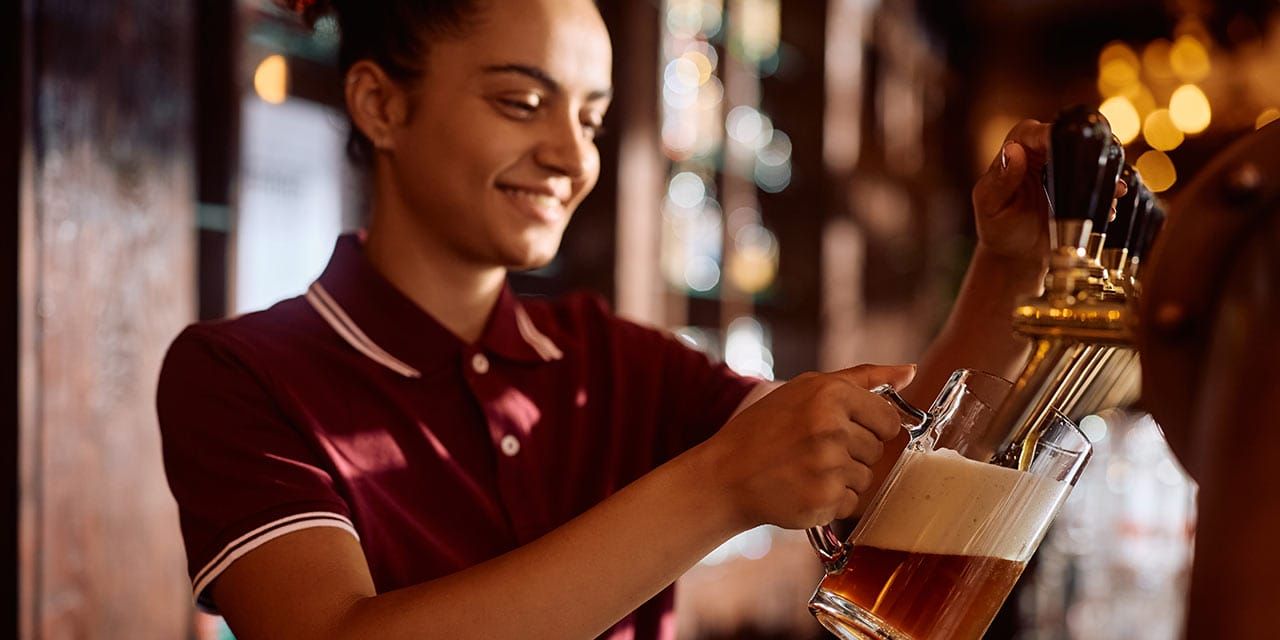
Below are a few examples.
- Casual pubs and sports bars: These establishments typically offer a laid-back atmosphere and the focus is on quick service of a wide range of beverages.
- High-end cocktail bars: These establishments often provide a more sophisticated setting, meaning Bartenders need to showcase a higher level of professionalism and be knowledgeable in mixology and even flair bartending to entertain guests.
- Hotels and restaurants with bars: Bartenders in hotels and restaurants need to be versatile, memorize drinks and keep track of many different orders delivered from Servers (including both alcoholic and non-alcoholic beverages) while also interacting with guests at the bar.
- Nightclubs: These are fast-paced environments that require Bartenders to constantly be on their toes, mixing and serving multiple drinks at a time while interacting with guests in an often loud and hectic setting.
- Events: Event Bartenders need to provide a high-level, personalized customer service to a particular clientele to help ensure the success of an event.
Key Traits to Look for in a Bartender
Different types of establishments require Bartenders to have a different set of qualifications. Still, some key qualifications for Bartenders are more or less the same across establishments. These include:
- Minimum age to prepare and serve alcoholic drinks
- TIPS certificate (if required by state)
- Interpersonal skills
- Basic mixology skills
- Familiarity with point-of-sale systems
- Ability to lift objects weighing up to 30–50 pounds
- Ability to work on feet for an extended time
- Inventory management experience
- Ability to multitask
Look for individuals who demonstrate adaptability and a strong work ethic, as these traits are essential in the dynamic environment of bartending. A Bartender who is passionate about their craft and continuously seeks to improve can significantly contribute to your establishment's success.
We also have a detailed career guide on what the Bartender position entails — check it out.
Assessing Bartender Certifications and Training
When evaluating potential Bartenders, it's beneficial to consider their formal certifications and training. Certifications such as TIPS (Training for Intervention ProcedureS) indicate a candidate's knowledge in responsible alcohol service, which can reduce liability risks for your establishment.
Additionally, completion of mixology courses or attendance at reputable bartending schools demonstrates a commitment to the craft and a solid foundation in drink preparation techniques. Prioritizing candidates with such credentials can enhance the professionalism and service quality of your bar staff.
How To Write a Bartender Job Description
Writing a compelling Bartender job description is essential to attracting qualified candidates, especially if you’re recruiting online. A Bartender’s job description should include the following:
- Job title
- Job overview
- Benefits
- Schedule
- Duties and responsibilities
- Experience and skills
- Education and other qualifications
Attracting and retaining top talent requires offering competitive pay and benefits. Make sure to investigate the average bartender salaries in your area to ensure your compensation packages are appealing. Also, implement performance-based incentives, such as bonuses for high sales or exceptional customer feedback, to motivate and reward your staff.
How To Interview a Bartender Candidate

One of the last steps for hiring a Bartender is the interview process. During this process, there are three types of evaluations you should do in order to assess who is the most suitable candidate:
- Skills and experience evaluation
- Customer service evaluation
- Situational and behavioral evaluation
We’ve compiled a list of essential Bartender interview questions that employers or hiring managers should ask candidates.
During the interview process, consider incorporating practical assessments to evaluate a candidate's hands-on skills. For instance, you might ask candidates to demonstrate their ability to craft classic cocktails, manage multiple drink orders under time constraints or handle a simulated customer complaint.
These practical evaluations provide insight into the candidate's technical abilities, composure under pressure and problem-solving skills, ensuring they can meet the demands of a busy bar environment.
How Long Is the Process for Hiring a Bartender?
If you're not hiring a Bartender through internal promotion, we recommend allocating at least five weeks* for the entire hiring process. Here's an example hiring timeline you can use as a basis:
- Week 1: Promote the job opening across your chosen channels (physical ads, social media and/or online job boards).
- Weeks 2 to 4: Gather enough applicants while also screening resumes and scheduling shortlisted candidates for an interview.
- Week 5: Finish conducting all interviews, proceed with deliberation over which one to hire and send out the job offer.
* Assuming you're not urgently hiring and you want to ensure you pick the most qualified candidate/s.
What Is the Cost of Hiring a Bartender?
While everything we’ve mentioned so far can be enticing for a hiring manager or business owner, does the cost of hiring a Bartender justify the cost? Let’s take a look at some of the costs associated with employing a Bartender.
The average base wage for Bartenders in the U.S. is $17.83 per hour (not including tips). Of course, this number will vary greatly based on the location and size of your establishment or event.
Other factors you should consider are the skill level and experience of the Bartender/s you want to hire. For instance, those who are highly skilled in mixology and have been bartending for over five years are likely to have a higher salary requirement than those with less experience.
For a more detailed insight about Bartender salaries across the U.S., check out our comprehensive Bartender salary guide.
Understanding Legal Requirements for Bartenders
Before finalizing your hiring decision, it's crucial to be aware of the legal requirements for Bartenders in your jurisdiction. Some regions mandate that bartenders obtain specific permits or licenses to serve alcohol. Additionally, age restrictions may apply, with laws varying on the minimum age for serving alcoholic beverages. Ensure that your candidates meet these legal criteria and possess any necessary documentation to comply with local regulations.
Hiring a Full-Time Bartender vs Part-Time Bartender
In the U.S., 52% of Bartenders are employed full-time, while 48% work part-time. Moreover, some establishments or companies opt to hire Bartenders on a seasonal or on-call basis.
That being said, there’s likely no shortage of candidates regardless of whether you’re looking for a full-time or part-time employee.
A lot of people work as Bartenders as a side gig, as it pays well and allows them to lead a healthy work-life balance. In fact, 39% of Bartenders in the U.S. are under 30 years old, meaning some Bartenders are likely students who prefer working part-time rather than full-time.

Having these things in mind, it’s up to you to decide whether your establishment or company needs a Bartender on a full-time, part-time, seasonal or on-call basis. If you’re hiring a Bartender for a nightclub, you might be better off with a part-time Bartender who’ll only work the evening shift.
On the other hand, if you run a catering or event planning company, then you’ll most likely only need Bartenders on a seasonal or on-call basis. Some restaurants need a Bartender who’s able to work full-time.
So if this is the case, your state’s labor laws may require you to provide your Bartender with benefits on top of their salary.
How To Hire a Bartender: Conclusion
Hiring the right Bartender is an important decision that can elevate your business's service quality and overall guest experience. By utilizing the strategies outlined in this guide, you’ll be able to attract and select a candidate who not only possesses the necessary skills but also aligns with your business’s culture and values.
Consider the specific needs of your establishment — whether it’s a high-energy nightclub, a laid-back pub or an upscale cocktail bar — and tailor your hiring approach accordingly. Offering competitive wages and benefits can further entice top talent and help retain quality staff who are committed to delivering exceptional service.




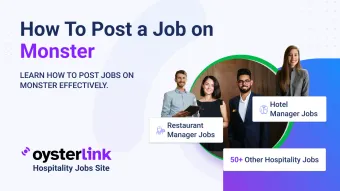
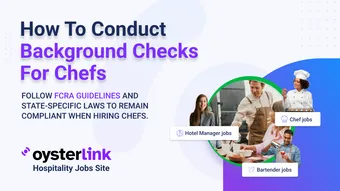
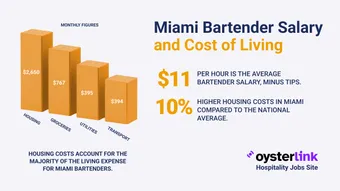
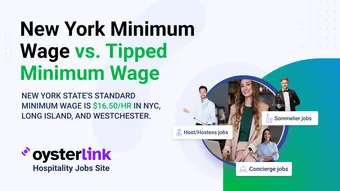


Loading comments...